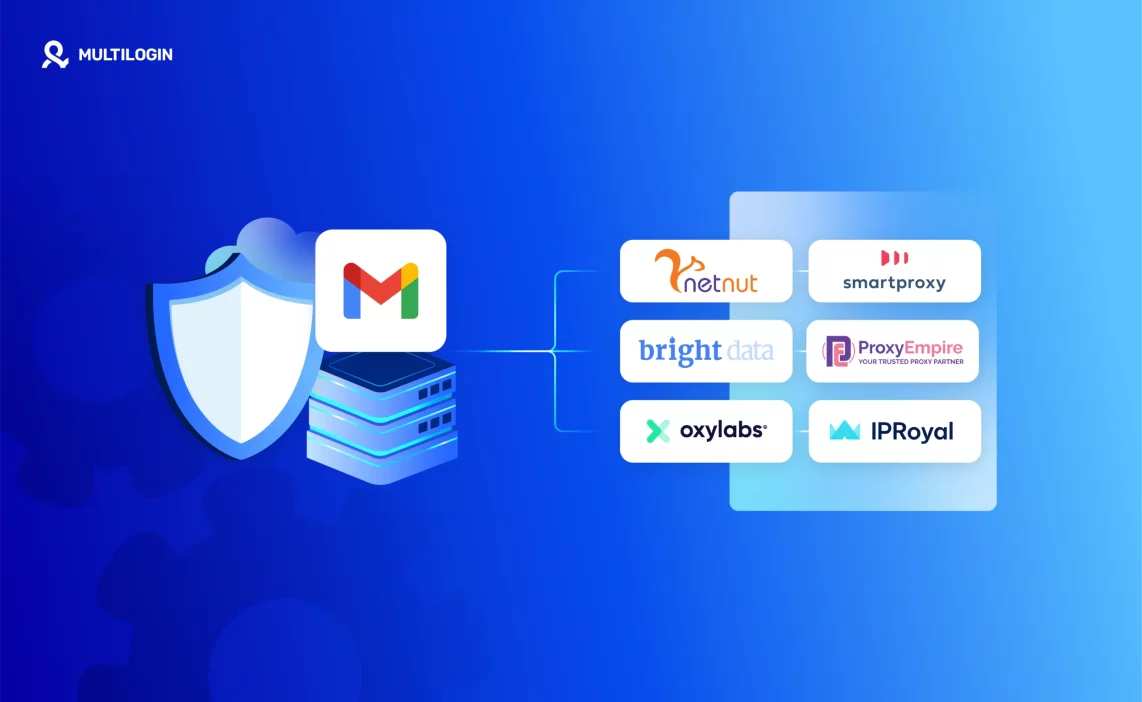Start now. Ditch the flags, keep the access. Try Multilogin today.
Managing multiple Gmail accounts, running outreach campaigns, or logging in from different countries? If you’ve tried doing any of that using the wrong proxy—or no proxy at all—you already know the pain:
- Endless “Verify it’s you” loops
- Temporary account suspensions
- Unexpected logouts
- Or even full bans without warning
Gmail is part of Google’s ultra-secure ecosystem. You’re not just dealing with login credentials here—you’re facing layer after layer of smart detection systems designed to keep out bots, fraudsters, and suspicious activity.
But you’re not a fraudster. You’re just trying to run a business, manage campaigns, or handle client inboxes.
So how do you access Gmail safely, securely, and repeatedly without issues?
This guide breaks it all down—from the best proxy sites for Gmail to the browser fingerprinting technology you absolutely need to pair with them to avoid detection in 2025.
Why Gmail Is So Aggressive About Blocking Proxies
Gmail is the #1 email service in the world. With over 1.8 billion active users, it’s also a favorite target for:
- Spam bots
- Phishing attacks
- Fake account creation
- Bulk automation tools
To fight back, Gmail doesn’t just block suspicious login attempts—it prevents them proactively using:
- IP geolocation monitoring
- Device fingerprinting
- Session tracking
- Login behavior patterns
- Proxy and VPN detection
Even if you’re using a real Gmail account for a legitimate purpose, Gmail might still flag or block you if your connection seems off.
And that’s where most proxy users get stuck.
Who Actually Needs Proxies for Gmail?
You’re not trying to hack Gmail—you just want stability, privacy, or scale.
Here’s who really benefits from using safe Gmail proxies:
1. Cold Email Agencies & Outreach Teams
Running 5, 10, or 100 Gmail inboxes for outreach campaigns? You need separate IPs and environments to protect deliverability and avoid linkages.
2. Freelancers & VAs Managing Client Accounts
Working with multiple clients’ Gmail or G Suite inboxes from one device? You’re a prime candidate for Gmail’s multi-login flags.
3. Remote Teams Working from Different Regions
If your team logs into Gmail accounts from multiple cities or countries, that’s enough to trigger suspicious activity warnings.
4. SaaS & eCommerce Businesses
Managing support inboxes, order updates, or regional email campaigns? You’ll need stable IP sessions to prevent constant logouts or security loops.
What Makes a Proxy “Gmail-Safe”?
Here’s what to look for in a Gmail-compatible proxy provider:
1. Residential IPs
These IPs come from real users, not data centers. Gmail sees them as natural and far less suspicious.
2. Sticky Sessions
Avoid rotating IPs mid-login. A sticky session ensures your Gmail session stays stable for 10–30 minutes or more.
3. Location Control
If you’re based in the US, but your IP says Brazil, Gmail may force you through verification. The best proxies let you choose your IP country or city.
4. Low Latency
A slow proxy can break the Gmail login flow. Speed matters.
5. Fresh IPs, Not Overused
Shared proxies often result in multiple users trying to access Gmail from the same IP, which leads to bans. Use clean, premium proxies only.
The Best Proxy Sites for Gmail in 2025 (Tested & Trusted)
Here’s our hand-picked list of Gmail-safe proxy providers. Each of these works best when paired with an antidetect browser, which we’ll cover right after this.
1. Nodemaven
Nodemaven offers residential proxies that are fast, stable, and highly compatible with Gmail. Their sticky sessions, city targeting, and real-user IPs make them the top choice for email marketers and virtual assistants.
Pros:
- Clean residential IPs from real devices
- Supports sticky and rotating sessions
- GEO targeting down to the city level
- Seamless integration with Multilogin
Best for: Gmail, G Suite, outreach, agency work
2. Oxylabs
Oxylabs offers one of the largest proxy pools globally. If you’re running hundreds of Gmail accounts and need fresh IPs constantly, they’re worth considering—especially for enterprise teams.
Pros:
- 100M+ IPs across 195+ locations
- Excellent uptime and delivery speeds
- Strong reputation across industries
Cons: Pricey, and may be too much for solo users or small teams
3. Smartproxy
Smartproxy gives you reliable access to residential proxies at reasonable prices. Their sticky IP sessions make them Gmail-friendly when paired with the right tools.
Pros:
- 40M+ residential IPs
- Sticky session support
- Good dashboard UX
Cons: Still needs fingerprint management via Multilogin to prevent account flags
4. IPRoyal
If you’re managing only a few Gmail accounts and need something affordable, IPRoyal’s residential proxies can do the job—just expect a smaller IP pool.
Pros:
- Cost-effective
- Easy to get started
- Decent speeds for basic use
Cons: Fewer advanced settings, limited proxy diversity
Why Proxies Alone Aren’t Enough for Gmail in 2025
Let’s say you buy a top-tier proxy and assign it to a Gmail login.
You still get flagged.
Why?
Because Gmail tracks browser fingerprints, including:
- Operating system
- WebGL data
- Canvas and audio rendering
- Fonts, plugins, timezone
- And dozens of other subtle signals
All of that forms your digital identity, and if it doesn’t match the new IP or past sessions—Gmail thinks you’re a hacker.
That’s why smart Gmail users now use Multilogin.
How Multilogin + Proxies = Gmail Login Success
Multilogin is an antidetect browser designed to create completely unique and isolated browser profiles. When paired with proxies, it gives Gmail zero reason to question your login behavior.
What You Can Do with Multilogin:
- Create unlimited virtual browser profiles
- Assign a different proxy to each Gmail account
- Customize fingerprints: OS, timezone, language, screen size, etc.
- Store cookies and sessions so you’re never asked to verify again
- Run multiple Gmail tabs or accounts without getting banned
Gmail Login Workflow (2025):
- Open Multilogin
- Create browser profile A → assign proxy A → log in to Gmail A
- Create browser profile B → assign proxy B → log in to Gmail B
- Repeat as needed. Each profile behaves like a unique person.
No account overlap. No suspicious login alerts. No bans.
Key Benefits of Using Multilogin for Gmail
- Persistent logins: Never reverify Gmail every time
- Profile isolation: Each Gmail account has its own device and IP
- Automation-friendly: Easily run outreach tools or Gmail tasks
- Scalable: Go from 5 to 500 Gmail accounts safely
- Client-friendly: Manage multiple inboxes without account linkage
Whether you’re an agency, freelancer, or founder—this is the Gmail management stack you need in 2025.
Ready to start managing Gmail the right way? Try Multilogin’s Proxy + Antidetect Bundle Now – Only €3.99!
Frequently Asked Questions About Best Proxy Sites for Gmail
VPNs change your IP, but they don’t separate browser fingerprints or allow sticky sessions. Gmail still flags them. Use residential proxies instead.
Yes. Using proxies is legal, but automating Gmail or violating their terms of service can result in account suspension.
As many as you want. Each account should have its own proxy and browser profile for total safety.
No. Multilogin emulates real browser environments. It doesn’t inject code or reveal that you’re using any third-party tools.
Want Gmail Stability? Don’t Just Use Any Proxy—Use the Right Setup
Let’s recap.
- Free proxy lists? Too risky. Gmail will block you.
- Datacenter proxies? Too obvious. Gmail will flag you.
- Even paid proxies? Useless if your browser fingerprint gives you away.
What you need is the right combination:
- High-quality residential proxies
- Browser fingerprint management from Multilogin
This isn’t a hack. It’s the professional standard for managing Gmail at scale without risking bans, lockouts, or losing access mid-campaign.



